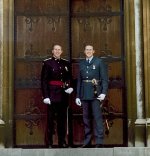jamiewakeham
Long time lurker
Hi all
I've had a V700 for a long time and never really been able to get what I want out of it. I've just spent most of today wrestling with it to see if I am just being stupid.
So. This is a crop of about the middle third of a 6x6 Portra VC400 neg. I am sure it's being held almost perfectly flat in the film holder - I've built a slightly Heath Robinson solution to the flimsy Epson holder. I've picked the sharpest of the three heights.
I've scanned using Epson Scan, in professional mode, at 2400dpi. I individually set the histograms for the three colour channels, then shifted the gamma of the overall channel to about 1.4 to pick up as much shadow detail as I could. No scanner enhancements (USM, ICE etc) at all. Saved as jpg at maximum quality.
Then, in the GIMP, I have just tweaked curves on the overall channel to bring out some contrast and try to give it a little pop. Resized from 5000 pixels across to 2000, and then USM (radius 3, amount 0.3, threshold 3). Cropped.
I end up with this.

It's muddy. It's not very sharp. If I try to bring out any more shadow detail I get awful granularity in the blacks, and if I sharpen any further it haloes.
On the other hand, the back-up shots with my RD1 came out like this:

Plenty of clarity and sharpness, with clear solid blacks and greys.
I just don't get it. Shouldn't medium format film at least vaguely equal a 15 year old 6MP camera?
I have never, ever got a scan I'm happy with out of the V700, and I start to wonder if it's actually defective. Or am I doing something wrong here?
I've had a V700 for a long time and never really been able to get what I want out of it. I've just spent most of today wrestling with it to see if I am just being stupid.
So. This is a crop of about the middle third of a 6x6 Portra VC400 neg. I am sure it's being held almost perfectly flat in the film holder - I've built a slightly Heath Robinson solution to the flimsy Epson holder. I've picked the sharpest of the three heights.
I've scanned using Epson Scan, in professional mode, at 2400dpi. I individually set the histograms for the three colour channels, then shifted the gamma of the overall channel to about 1.4 to pick up as much shadow detail as I could. No scanner enhancements (USM, ICE etc) at all. Saved as jpg at maximum quality.
Then, in the GIMP, I have just tweaked curves on the overall channel to bring out some contrast and try to give it a little pop. Resized from 5000 pixels across to 2000, and then USM (radius 3, amount 0.3, threshold 3). Cropped.
I end up with this.

It's muddy. It's not very sharp. If I try to bring out any more shadow detail I get awful granularity in the blacks, and if I sharpen any further it haloes.
On the other hand, the back-up shots with my RD1 came out like this:

Plenty of clarity and sharpness, with clear solid blacks and greys.
I just don't get it. Shouldn't medium format film at least vaguely equal a 15 year old 6MP camera?
I have never, ever got a scan I'm happy with out of the V700, and I start to wonder if it's actually defective. Or am I doing something wrong here?


